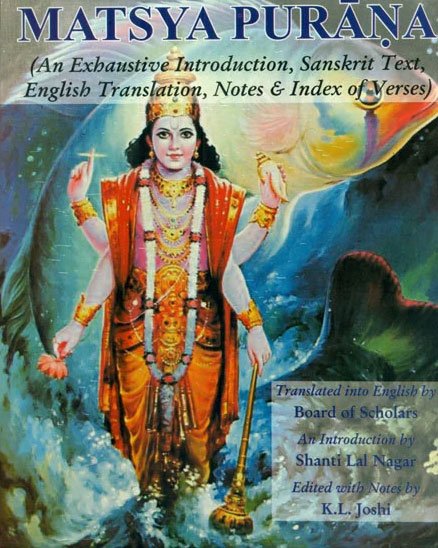The Matsya Purana (critical study)
by Kushal Kalita | 2018 | 74,766 words | ISBN-13: 9788171103058
This page relates ‘Vedic and Puranic sources of Architecture (vastu)’ of the English study on the Matsya-purana: a Sanskrit text preserving ancient Indian traditions and legends written in over 14,000 metrical verses. In this study, the background and content of the Matsyapurana is outlined against the cultural history of ancient India in terms of religion, politics, geography and architectural aspects. It shows how the encyclopedic character causes the text to deal with almost all the aspects of human civilization.
Part 1b - The Vedic and Purāṇic sources of Architecture (vāstu)
In the domain of Sanskrit literature evidences of early Indian architecture [i.e., vāstu] are found in the Vedas.[1] The people of that age learnt the art of constructing houses, doors, pillars etc. They were also very much aware of forts, walled cities, stone houses and carved stones. In the Ṛgveda two sūktas are identified as Vāstospati Sūkta where Vāstospati is worshipped as the chief god of Vāstuvidyā. Vāstospati is worshipped as the protector of building and property.[2] The Ṛgveda has references about residential houses with thousand doors and thousand pillars and also about large and graceful halls with numerous pillars.[3] Mitra and Varuṇa occupied a great palace with thousand pillars and thousand gates.[4] Sage Vaśiṣṭha expressed his desire for three storied dwelling.[5] References of town, city, fort etc. are also found in this Veda.[6]
In the Ṛgveda the grave is described as mṛnmaya gṛha.[7] Gṛha is more frequently referred to in the Atharvaveda.[8] In the Śatapathabrāhmaṇa,[9] Vājasaneyīsaṃhitā,[10] Sāṃkhyāyaṇagṛhyasūtra,[11] Āśvalāyanagṛhyasūtra,[12] Gobhilagṛhyasūtra[13] references of various architectural works are found. The construction of vedī is regarded as the beginning of any religious architecture.[14] The earliest record of vedī or alter is found in the Taittirīyasaṃhitā.[15] In comparison to Vedic literature, the Purāṇas have treated the science of architecture very systematically. Purāṇas like Agni, Viṣṇudharmottara, Nārada, Matsya, Skaṇḍa, Vāyu, Brahmāṇḍa, Bhaviṣya and Mārkaṇḍeya have descriptions on architecture and sculpture in great extent. The Skaṇḍapurāṇa has given references to the laying out of large cities,[16] construction of golden hall and three chariots.[17] It has also mentioned the details of the construction of a special pavilion for the wedding of a royal princess.[18] In the 46th Chapter of the Garuḍapurāṇa systematic analysis is made of the three types of buildings viz., residential, for military and religious. It has also described pavilions, pleasure gardens, forts, towns and monasteries. The Agnipurāṇa has dealt with the town planning, residential buildings and mostly with the sculpture in its 104th to 106th chapters.
The Nāradapurāṇa has described the construction of pools, wells, tanks as well as temples.[19] The Vāyupurāṇa has also the description of the construction of temples.[20] Besides these references, the Mahābhārata and the Rāmāyaṇa have also furnished many descriptions of cities, buildings, enclosing walls, balconies and many other structures. The temples (devāyatana) of Ayodhyā as described in the Rāmāyaṇa have thrown light on the system of architecture available in that period of time. The architectural ideas are well reflected in the Mahābhārata through the descriptions of cities like Dvārakā, Indraprastha, Mithilā, Rāvaṇa's Laṅkā etc. Apart from the epics and Purāṇas there are other ancient Sanskrit texts also where architecture is discussed elaborately. The Arthaśāstra, Mayamata, Mānasāra, Brhatsaṃhitā, Samarāṅgaṇasūtradhāra, Muhurtacintāmani and many others throw abundant light on architecture.
Footnotes and references:
[1]:
Cf., Ṛgveda, 4.148.200, 2.313, 2.41.5, 4.179, 5.62.6
[2]:
Ibid.,7.54.1
[3]:
Ibid., 2.41.5, 2.313
[4]:
Ibid., 5.62.6
[5]:
Ibid., 4.148
[6]:
Ibid., 1.58.8; 1.144.1; 2.20.8; 4.27.1; 4.30.20; 8.3.7; 8.15.14; 8.89.8; 8.95.1; 1.66.8; 7.15.14
[7]:
Ibid.,7.89.1
[8]:
Atharvaveda, 18.3.51
[9]:
Śatapathabrāhmaṇa,11.1.1.2, 14.3.1.1.3
[10]:
Vājasaneyīsaṃhitā, 30.10
[11]:
Sāṃkhyāyaṇagṛhyasūtra, 3.2
[12]:
Āsvālayaṇagṛhyasūtra, 2.7–9
[13]:
Gobhilagṛhyasūtra, 4.15-19
[15]:
Taittirīyasaṃhitā, 5.4.11
[16]:
Skandapurāṇa, Māheśvarakhaṇḍa, 2.25
[17]:
Ibid., Vaiṣṇavakhaṇḍa, 2.25
[18]:
Ibid., Māheśvarakhaṇḍa, 1.24
[19]:
Nāradapurāṇa, Pūrvabhāga, ch. 13
[20]:
Vāyupurāṇa, ch. 39
